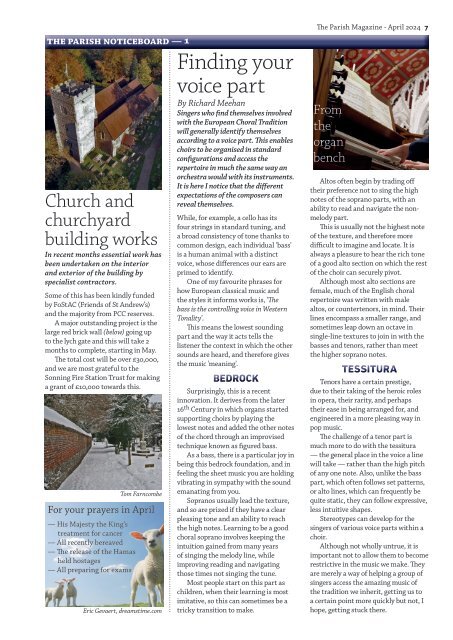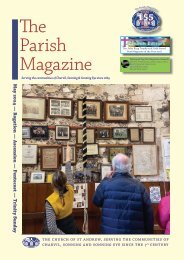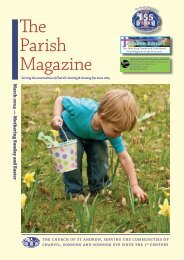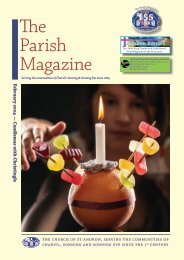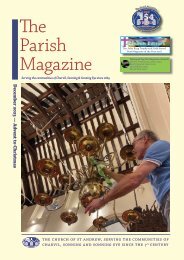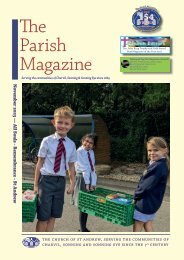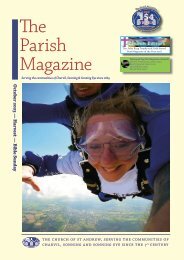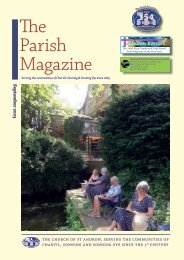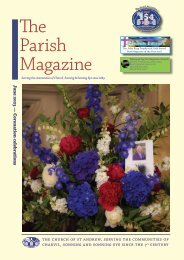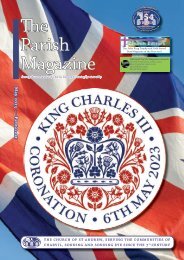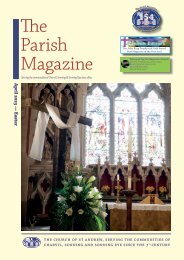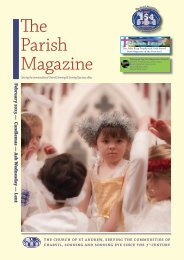The Parish Magazine April 2024
Serving the communities of Charvil, Sonning, and Sonning Eye since 1869
Serving the communities of Charvil, Sonning, and Sonning Eye since 1869
Create successful ePaper yourself
Turn your PDF publications into a flip-book with our unique Google optimized e-Paper software.
the parish noticeboard — 1<br />
Church and<br />
churchyard<br />
building works<br />
In recent months essential work has<br />
been undertaken on the interior<br />
and exterior of the building by<br />
specialist contractors.<br />
Some of this has been kindly funded<br />
by FoStAC (Friends of St Andrew’s)<br />
and the majority from PCC reserves.<br />
A major outstanding project is the<br />
large red brick wall (below) going up<br />
to the lych gate and this will take 2<br />
months to complete, starting in May.<br />
<strong>The</strong> total cost will be over £30,000,<br />
and we are most grateful to the<br />
Sonning Fire Station Trust for making<br />
a grant of £10,000 towards this.<br />
For your prayers in <strong>April</strong><br />
— His Majesty the King’s<br />
treatment for cancer<br />
— All recently bereaved<br />
— <strong>The</strong> release of the Hamas<br />
held hostages<br />
— All preparing for exams<br />
Tom Farncombe<br />
Eric Gevaert, dreamstime.com<br />
Finding your<br />
voice part<br />
By Richard Meehan<br />
Singers who find themselves involved<br />
with the European Choral Tradition<br />
will generally identify themselves<br />
according to a voice part. This enables<br />
choirs to be organised in standard<br />
configurations and access the<br />
repertoire in much the same way an<br />
orchestra would with its instruments.<br />
It is here I notice that the different<br />
expectations of the composers can<br />
reveal themselves.<br />
While, for example, a cello has its<br />
four strings in standard tuning, and<br />
a broad consistency of tone thanks to<br />
common design, each individual 'bass'<br />
is a human animal with a distinct<br />
voice, whose differences our ears are<br />
primed to identify.<br />
One of my favourite phrases for<br />
how European classical music and<br />
the styles it informs works is, '<strong>The</strong><br />
bass is the controlling voice in Western<br />
Tonality'.<br />
This means the lowest sounding<br />
part and the way it acts tells the<br />
listener the context in which the other<br />
sounds are heard, and therefore gives<br />
the music 'meaning'.<br />
BEDROCK<br />
Surprisingly, this is a recent<br />
innovation. It derives from the later<br />
16 th Century in which organs started<br />
supporting choirs by playing the<br />
lowest notes and added the other notes<br />
of the chord through an improvised<br />
technique known as figured bass.<br />
As a bass, there is a particular joy in<br />
being this bedrock foundation, and in<br />
feeling the sheet music you are holding<br />
vibrating in sympathy with the sound<br />
emanating from you.<br />
Sopranos usually lead the texture,<br />
and so are prized if they have a clear<br />
pleasing tone and an ability to reach<br />
the high notes. Learning to be a good<br />
choral soprano involves keeping the<br />
intuition gained from many years<br />
of singing the melody line, while<br />
improving reading and navigating<br />
those times not singing the tune.<br />
Most people start on this part as<br />
children, when their learning is most<br />
imitative, so this can sometimes be a<br />
tricky transition to make.<br />
<strong>The</strong> <strong>Parish</strong> <strong>Magazine</strong> - <strong>April</strong> <strong>2024</strong> 7<br />
From<br />
the<br />
organ<br />
bench<br />
Altos often begin by trading off<br />
their preference not to sing the high<br />
notes of the soprano parts, with an<br />
ability to read and navigate the nonmelody<br />
part.<br />
This is usually not the highest note<br />
of the texture, and therefore more<br />
difficult to imagine and locate. It is<br />
always a pleasure to hear the rich tone<br />
of a good alto section on which the rest<br />
of the choir can securely pivot.<br />
Although most alto sections are<br />
female, much of the English choral<br />
repertoire was written with male<br />
altos, or countertenors, in mind. <strong>The</strong>ir<br />
lines encompass a smaller range, and<br />
sometimes leap down an octave in<br />
single-line textures to join in with the<br />
basses and tenors, rather than meet<br />
the higher soprano notes.<br />
TESSITURA<br />
Tenors have a certain prestige,<br />
due to their taking of the heroic roles<br />
in opera, their rarity, and perhaps<br />
their ease in being arranged for, and<br />
engineered in a more pleasing way in<br />
pop music.<br />
<strong>The</strong> challenge of a tenor part is<br />
much more to do with the tessitura<br />
— the general place in the voice a line<br />
will take — rather than the high pitch<br />
of any one note. Also, unlike the bass<br />
part, which often follows set patterns,<br />
or alto lines, which can frequently be<br />
quite static, they can follow expressive,<br />
less intuitive shapes.<br />
Stereotypes can develop for the<br />
singers of various voice parts within a<br />
choir.<br />
Although not wholly untrue, it is<br />
important not to allow them to become<br />
restrictive in the music we make. <strong>The</strong>y<br />
are merely a way of helping a group of<br />
singers access the amazing music of<br />
the tradition we inherit, getting us to<br />
a certain point more quickly but not, I<br />
hope, getting stuck there.


